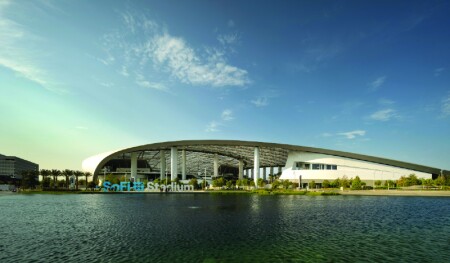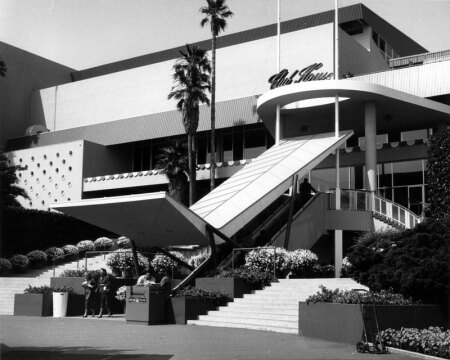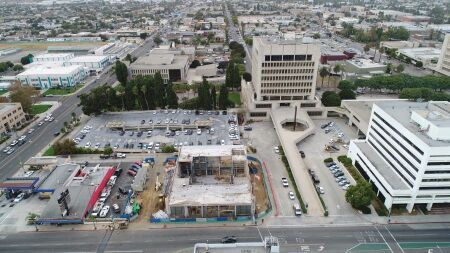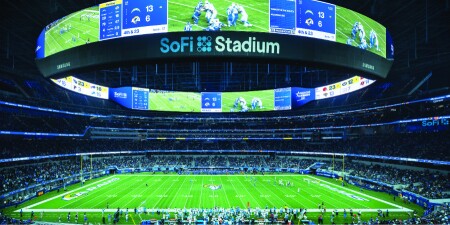In 2011, the city of Inglewood was on the brink of bankruptcy. After decades of decline, the city had a BBB-minus bond rating, a 17 percent unemployment rate, and crumbling infrastructure. By September 2011, the city would be cash bankrupt, unable to make payroll.
Twelve years later, it’s astonishing, inconceivable even, to recall that Inglewood was once in such disarray. Today, the city is a vibrant enclave of Greater Los Angeles and a destination for shopping, entertainment, and sports.
For all of its problems, Inglewood had one ace to play: a nearly 300-acre development site at the center of the city. Formerly home to the Hollywood Park Racetrack, the site was the largest contiguous development opportunity in urban Southern California, and it proved to be the solution to the city’s financial problems.
When James T. Butts was elected mayor in 2011, he set out to attract an NFL team to Inglewood and to build a new stadium on the Hollywood Park location. SoFi Stadium at Hollywood Park, as it would become known, catalyzed a transformative resurgence in the city and propelled Inglewood into a new era of glory.
Solving an urgent financial problem
Mayor Butts was aggressive in his pursuit of an NFL team that would move to Inglewood and shopped the Hollywood Park site as an ideal location for a stadium development. He saw a sports team as a way to lift the city out of debt and support long-term economic growth by creating jobs, supporting local businesses, and generating tax revenue—and the city had a good historical precedent as a sports hub.
When it was home to the Los Angeles Lakers and Los Angeles Kings, Inglewood was known as the City of Champions. “Sports and entertainment brings people from outside of the city into your city. They come and spend money, and they contribute to your tax space,” Mayor Butts says. “I was determined to make the city a sports and entertainment destination once again.”
NFL teams showed enthusiastic interest in the development site, and in early 2014, Stan Kroenke, a real estate mogul and owner of the Los Angeles Rams, announced plans to develop an NFL stadium and relocate the Rams to the site. Then, the Chargers also announced plans to relocate to the city, giving Inglewood two NFL teams to drive growth. In the years since, the Los Angeles Clippers have also relocated to Inglewood. That team will play at the Intuit Dome, a basketball stadium that is currently under construction amid plans for it to open next year.
A stadium was the crown jewel of a larger mixed-use district at Hollywood Park, which includes housing, office, retail, a hotel, and 25 acres (10 ha) of outdoor space, developed by the Hollywood Park Land Co., a joint venture between the Kroenke Group and Stockbridge Capital Group. An analysis at the time from the Associated Press found that the project would generate $100 million in tax revenue in the first five years, and the developer estimated the project would generate more than $1 billion in the first 25 years.
“It was a boon for Inglewood financially at a time when they were teetering on bankruptcy,” says Tim Kawahara, executive director of the Ziman Center for Real Estate at UCLA’s Anderson School of Management. “There was some concern from the community, but all in all, it was a fairly easy sell to have investment come into an underinvested city and put it [on much better] financial footing.”
Stan Kroenke’s vision
From the Hollywood Park redevelopment’s conception, Stan Kroenke wanted to create a world-class entertainment venue that would bring cachet to Inglewood. “He wanted to do something that was extraordinary,” says Scott Hunter, regional director and partner at HKS, the architecture firm behind SoFi Stadium. “He wanted us to do something that had never been done before.”
The 70,000-seat stadium took six years to build and cost an estimated $5 billion. The site had been previously entitled for a residential mixed-use neighborhood with ground-level retail, according to Hunter, but the addition of a stadium transformed the initial vision and amplified the potential benefits. “It is really rare to have a 300-acre [120 ha] parcel of land available in the heart of a major metropolitan city,” Hunter notes. “The insertion of a stadium of this scale and magnitude was a real game changer [for] what this site could turn into.”
HKS looked to the Greater Los Angeles landscape for inspiration. The roof of the stadium mirrors the waves in the nearby Pacific Ocean, and guests enter the stadium at the top and descend into it, as you would down cliffside stairs to the beach. The proximity to the airport limited the height allowance for the building, requiring that it be embedded into the ground, an unusual characteristic for a stadium of this size.
The project also broke new boundaries by featuring the largest ETFE clear film roof in the world, as well as the first Oculus scoreboard—a doubled-sided 4K screen—ever created. “It … is attracting people [who] want to experience that, even if they never get to buy a ticket to go to the game,” Hunter says. This year, in its annual ranking of U.S. sports arenas, The Athletic named SoFi Stadium the second-best NFL stadium.
The stadium was designed to support events 365 days per year. In addition to being home to two NFL teams, SoFi has hosted the Super Bowl and major concerts (this year, Taylor Swift played at SoFi during the Los Angeles portion of her Eras Tour), and it will host World Cup games in 2026 and Olympics events in 2028. Although Los Angeles has several stadiums and entertainment venues, since the 2020 opening of SoFi Stadium, it has quickly become the city’s favorite for sports and entertainment.
Community-serving growth
Stadium developments don’t always catalyze growth and investment in a community. In fact, most studies show that sports stadiums typically have nearly no positive economic impact on their surrounding communities. Inglewood, however, was able to harness the power and potential of the project to benefit the community and drive substantial growth.
According to Mayor Butts, community-serving benefits begin with a strong development agreement. “If you don’t want to be a city where people come in, spend money, and then go home, leaving the residents to absorb the impact of a transient population, it starts with the original development arrangement,” he explains—and Inglewood’s deal with the developer was exceptional.
To start, Inglewood did not invest any upfront tax dollars into the project and was not obligated to reimburse the developer for such city-related amenities as roadways and streetlights until the development generated $25 million in tax revenue. In addition, the development deal included a mandate to hire 35 percent local labor and use 15 percent of local businesses and vendors once the project was complete.
“You have to ensure participation by residents and local businesses,” Mayor Butts says. Those provisions have had a substantial impact on local employment, lowering Inglewood’s unemployment rate from 17 percent to 4.7 percent before the pandemic. According to Butts, Inglewood’s is among the lowest unemployment rates in the country for a minority-majority city.
The community was rightly worried about gentrification and displacement, though the benefits of the stadium project largely outweighed any apprehension. Still, to assuage concerns, the city implemented strict rent stabilization laws that capped rent increases at 3 percent of CPI, the strongest rent cap in the Greater Los Angeles area, and supported the preservation and development of affordable housing. According to Mayor Butts, Inglewood currently has the lowest median rents in the South Bay and the largest number of affordable housing units per capita there.
Community outreach was integral to ensuring that the investment benefitted the existing residents. Shortly after the project was announced, UCLA did a series of educational sessions at local and predominately Black churches to urge homeowning residents not to sell to speculative, all-cash investors. It was good advice.
Total real estate values have increased from $9 billion to $17 billion since the project was first announced. “The people in Inglewood were in favor of something happening that would be an economic benefit, and this could create generational wealth for people,” Hunter says.
The development team also connected with the local community to ensure the project would include essential amenities. Hunter says the development team had an “assertive desire” to build a deep connection with residents. The team wanted to create a space that would not only serve as an entertainment destination but would also be embraced by the local community. “It has proven out pretty well so far,” he adds. “The community is proud that they had a part in creating it.”
Ripe for redevelopment
Although the stadium certainly jumpstarted the transformation in Inglewood, Kawahara argues that the city was already an ideal candidate for this type of transformation because it has “innate advantages.” Those advantages include the Westside location and affordability compared to other neighborhoods in the South Bay, as well as proximity to LAX, two major freeways, and expanding public transit.
“It was one of the few places where you could find under-median-priced homes on the Westside,” says Kawahara. The city had been skipped over for investment largely due to a negative brand, according to Mayor Butts.
Before the start of the stadium development, however, Kawahara and his colleagues had predicted a resurgence in Inglewood. Today, demographics are shifting, and that transformation has taken shape.Hunter saw the same benefits when he began to design the stadium project. “There are so many advantages to living in Inglewood that the people that were already there knew about,” he says. “Now, they are benefitting from it.”
The transformation of the city ultimately stemmed from an amalgamation of factors. A massive stadium project and the introduction of two NFL teams was certainly a strong start, but an ideal location and strong leadership equally helped to drive the economic growth and additional investment.
Development takes off
The redevelopment of Hollywood Park and the addition of SoFi stadium have motivated an impressive series of projects. First, Inglewood will welcome the Los Angeles Clippers, a basketball team, to the newly constructed 18,000-seat, $2 billion Intuit Dome next year.
The city has also seen an influx of inward migration from both businesses and residents. The Los Angeles Philharmonic’s Youth Orchestra Los Angeles, the Girl Scouts of Greater Los Angeles, the 6,000-seat YouTube Theater, and Showtime’s offices have all moved into Inglewood.
On the development front, Rob McRitchie, senior director of capital markets at JLL, says that multifamily investors and developers are targeting the city. According to Richie, there is appetite from both private and institutional capital to develop market-rate and affordable housing deals. From 2018 to 2021, there were almost 4,000 units in the construction pipeline in Inglewood. By comparison, from 2000 to 2017, the city gained only 448 new housing units.
Local government is continuing to drive growth and improvements in the city through development and redevelopment. It recently worked with the Los Angeles Chapter of ULI to complete a technical advisory panel to make recommendations for the redevelopment of the Crenshaw Boulevard Corridor.
The mayor says that his top priority is renewing infrastructure that had been ignored for four decades before he took office, as well as expanding the K Line. For the latter, the city has already raised $800 million in grants and is petitioning the federal government for the remaining $900 million to fund the transit project. A lot of growth still looms for Inglewood.
“Mayor Butts is unabashedly pro-development,” Kawahara says. “He has invited development, but the city has also done a lot of community outreach to ensure that it would include amenities for the city.”
According to Mayor Butts, gaining community trust is the key to incentivizing development and economic growth. “We have a community that trusts their city council to make decisions with the community’s interest,” he says.
This balancing act between growth and community has been critical to Inglewood’s success. The stadium project provided a reason to build in the area, but the rest of the growth was the result of strong leadership and an engaged community.
“These kinds of buildings can do that if they are planned appropriately and built into the community in a meaningful way,” Hunter says. “In combining this all together, Inglewood has become the City of Champions once again.”
KELSI MAREE BORLAND is a freelance journalist and magazine writer based in Los Angeles.










